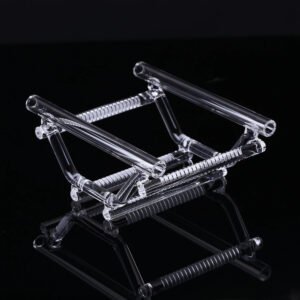Wafer Boat
Available in vertical & horizontal designs, our wafer boats cater to 8” & 12” wafers. Diverse materials—quartz for high-purity high-temp processes, SiC for thermal shock resistance, ceramics for wet etching—ensure optimal performance. Ideal for oxidation, diffusion, and CVD, with customizable slot pitches down to ±0.01mm. Trust our solutions to safeguard your wafers and drive scientific innovation.
- High-Purity Quartz:99.99% ultra-pure quartz, zero contamination in oxidation/diffusion, protects experiment integrity.
- Superior Silicon Carbide:High-strength SiC, 5x wear resistance, withstands extreme heat & heavy use.
- Advanced Ceramic Alloys:Specialized ceramics, excellent chemical resistance, stable in wet etching and various temps.
- Composite Material Blend:Combines quartz's thermal stability & ceramics' strength for top performance in semiconductors.
What Is a Wafer Boat?
At its core, a wafer boat is a structured container with evenly spaced slots or grooves that secure semiconductor wafers (silicon, SiC, GaAs, etc.) in a fixed position during thermal or chemical processing. Its defining characteristics include:
Extreme Temperature Resistance: Operates reliably in furnaces up to 1,600 °C (depending on material), with minimal warping or degradation.
High Purity: Constructed from ultra-clean materials (≥99.99 % purity) to avoid contaminating wafers with particles or metal ions—critical for logic chips and power devices.
Precision Alignment: Slot spacing (typically 2–5 mm) and depth are calibrated to hold wafers vertically or horizontally without tilting, ensuring uniform heat distribution or coating.
Batch Compatibility: Holds 10–100+ wafers per unit, enabling efficient batch processing that reduces manufacturing time and cost.



Key Distinction: Wafer boats are for in-process use (exposed to heat, plasma, or chemicals), while wafer cassettes are for post-process storage/transport (room temperature only).
Core Types of Wafer Boats: Materials & Designs
By Material
| Material | Max Operating Temperature | Key Properties | Ideal Applications |
|---|---|---|---|
| Fused Quartz (SiO₂) | 1,150–1,250 °C | Ultra-high purity (<5 ppm metal impurities); low thermal expansion; transparent to UV/visible | Standard silicon processing: diffusion, oxidation, low-temp epitaxy |
| Silicon Carbide (SiC) | up to 1,600 °C | Exceptional thermal shock resistance; high mechanical strength; resistant to harsh acids/gases | Advanced high-temperature processes: SiC wafer annealing, high-power CVD |
| Silicon (Poly/Mono) | ~1,000–1,100 °C | Wafer-matched thermal expansion; no lattice mismatch with silicon wafers | Silicon-on-silicon epitaxy, high-purity annealing |
| Aluminum Oxide (Al₂O₃) | 1,300–1,400 °C | Cost-effective; good chemical stability; moderate purity | Low-to-mid temperature processes: wafer cleaning, solar PV diffusion |
Industry data show fused quartz wafer boats dominate ~70–75 % of the market because of their versatility and compatibility with mainstream silicon fabs.
By Design
| Design Type | Key Features | Wafer Size Compatibility | Furnace Type |
|---|---|---|---|
| Vertical Slot Boat | Slots oriented vertically; stackable for space efficiency | 4–12 inches | Vertical furnaces (high-volume production) |
| Horizontal Slot Boat | Slots oriented horizontally; open-top for easy wafer loading | 2–6 inches | Horizontal furnaces (small-batch R&D, custom wafers) |
| Custom Grooved Boat | Tailored slot width/depth; rounded edges to prevent wafer chipping; optional push-pull rods | Any size (2–12 inches) | Thin wafers (<100 μm), compound semiconductors (GaAs, GaN), or specialty processes |
Critical Specifications for Wafer Boats
1. Wafer Size & Capacity
| Wafer Diameter | Typical Slot Width | Capacity (Per Boat) |
|---|---|---|
| 4 inches (100 mm) | 102–105 mm | 25–50 wafers |
| 6 inches (150 mm) | 152–155 mm | 20–40 wafers |
| 8 inches (200 mm) | 203–206 mm | 15–30 wafers |
| 12 inches (300 mm) | 305–308 mm | 10–20 wafers |
2. Quality Metrics
| Metric | Definition | Typical Range (Quartz) | Impact |
|---|---|---|---|
| Slot Precision | Uniformity of slot width/depth across the boat | ±0.1–0.2 mm | Prevents wafer pinching or loose fitting |
| Surface Roughness (Ra) | Smoothness of slot surfaces | <0.5 µm | Prevents wafer scratches or particle shedding |
| Impurity Level | Metal/oxide contaminants in the material | <5 ppm (total metals) | Avoids doping or contamination of wafers |
Key Applications: Where Wafer Boats Add Value
1. Silicon Wafer Processing
Diffusion: Fused quartz boats hold wafers during dopant diffusion (e.g., boron/phosphorus) at 900–1,100 °C, with high purity preventing dopant cross-contamination.
Oxidation: Vertical slot boats ensure wafers are evenly exposed to oxygen/steam, creating uniform SiO₂ layers.
2. Compound Semiconductor Processing
GaN/SiC Wafers: SiC or high-purity quartz boats withstand the 1,200–1,600 °C temperatures needed for GaN/SiC epitaxy, with thermal stability preventing wafer warping.
GaAs Wafers: Custom grooved silicon boats (matched to GaAs thermal expansion) reduce chipping during low-temperature annealing (800–900 °C).
3. Specialty Applications
Thin Wafer Processing: Ultra-thin wafers (<50 μm) require custom boats with soft, rounded slots to avoid breakage.
Solar PV Wafers: Cost-effective aluminum oxide boats hold silicon PV wafers during diffusion, balancing performance and budget.
How to Select the Right Wafer Boat?
1. Pick the Right Material:
• High-temperature processes (>1,200 °C): SiC boats.
• Standard silicon processes: Fused quartz boats.
• Cost-sensitive mid-temp processes: Aluminum oxide boats.
2. Match Design to Furnace & Batch Size:
• Vertical furnaces: Vertical slot boats.
• Horizontal furnaces: Horizontal slot boats.
• Thin/odd-sized wafers: Custom grooved boats with rounded edges.
3. Verify Wafer Size & Capacity:
• Ensure slot width is slightly larger than wafer diameter.
• Choose capacity based on batch needs.
Why Choose Us – Custom Wafer Boat Solutions?
Beyond standard wafer boats, we provide customized services to match your exact process. This includes custom slot counts and spacing, push-pull rod interfaces, material grade selection, surface/edge polishing, traceability certificates, and rapid prototyping.
These properties make our wafer boats ideal for high-temperature and high-frequency devices where silicon cannot perform. We can also provide fully customized services—please contact us for support.
Maintenance Tips to Extend Wafer Boat Life
Prevent Thermal Shock: Preheat boats to 200–300 °C before inserting into high-temp furnaces; cool down gradually.
Regular Cleaning: For quartz boats, use a mild HF acid bath followed by DI rinse every 2–3 weeks.
Inspect Before Use: Check for cracks, warped slots, or particle buildup.
Proper Storage: Store in a clean, dry environment (Class 100 cleanroom recommended) with protective sleeves.
FAQs:
1. Can I customize wafer boats with special sizes or structures?
Customization is available. Provide wafer size, process parameters, and special functional requirements (e.g., built-in sensors)
2. Which processes are suitable for different wafer boat materials (such as quartz, silicon carbide, and ceramics)?
High-purity quartz is ideal for high-temperature clean processes like oxidation and diffusion; silicon carbide, with its excellent wear resistance, suits high-frequency thermal cycling; ceramic alloys perform best in highly corrosive environments such as wet etching.
3. How do I select the right wafer boat model for 12-inch wafers?
Ensure the slot pitch and loading capacity match the wafer size. Also, consider process temperature, corrosiveness, and choose the appropriate material and structure accordingly.
4. What is the maximum temperature resistance of wafer boats?
Quartz materials can withstand up to 1200°C, while silicon carbide can endure temperatures above 1600°C. Refer to the product specification for precise details.
5. Will wafer boats release impurities to contaminate wafers after long-term high-temperature use?
High-purity quartz (99.99%) and special ceramic materials have strong chemical stability, with minimal impurity release under normal usage.
6. Can I process different types of wafers in the same wafer boat?
Not recommended to avoid cross-contamination. If necessary, ensure the wafers have non-reactive surfaces and compatible process conditions.
7. How do I clean a wafer boat?
After high-temperature processes, soak it in a diluted hydrofluoric acid (HF) solution to remove residues. For wet processes, rinse with deionized water and dry thoroughly.
8. What is the lifespan of a wafer boat?
It depends on usage frequency, temperature, and corrosiveness. Generally, quartz boats last 50-100 high-temperature cycles, while silicon carbide boats last longer.
9. Can wafer boats be used in a vacuum environment?
Most wafer boats support vacuum processes, but verify the material’s stability under vacuum and high temperatures.
10. How can I prevent wafers from sliding or breaking in the wafer boat?
Choose products with precise slot pitch (±0.01mm) and anti-slip inner walls. Ensure wafers are fully seated during loading.
11. Are wafer boats compatible with automated robotic arms?
Most models are designed for robotic arm compatibility. When purchasing, confirm that the interface size and gripping points match.
12. What are the advantages of composite-material wafer boats compared to single-material ones?
They combine the properties of multiple materials, such as the thermal stability of quartz and the mechanical strength of ceramics, fitting complex process requirements.
13. How should I transport and store wafer boats?
Use anti-static, scratch-resistant packaging boxes. Store in a dry, dust-free environment, avoiding heavy pressure and collisions.
14. Do surface scratches on wafer boats affect their performance?
Minor scratches have little impact, but deep ones may trap contaminants. Regularly inspect and replace severely damaged boats.
15. Are wafer boats from different brands interchangeable?
Check the size, slot type, and interface standards. Products compliant with SEMI specifications have higher compatibility.
16. Are wafer boats from different brands interchangeable?
Check the size, slot type, and interface standards. Products compliant with SEMI specifications have higher compatibility.
17. How do I know when to replace a wafer boat?
Yes, preheat it to 50%-70% of the process temperature before high-temperature processes to prevent thermal shock caused by large temperature differences.
18. What does the warranty policy cover when purchasing a wafer boat?
The warranty period is usually 6-12 months, covering material defects and structural damages caused by non-human factors.
REQUEST A QUOTE
Our professional team will reply to you within one business day. Please feel free to contact us!

